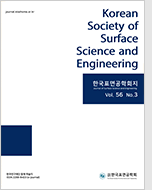
- Past Issues
- e-Submission
-

2021 Impact Factor 1.766
5-Year Impact Factor 1.674
Editorial Office
- +82-2-563-0935
- +82-2-558-2230
- submission@kssse.or.kr
- https://www.kssse.or.kr/

2021 Impact Factor 1.766
5-Year Impact Factor 1.674
The Korean Society of Surface Science and Engineering 2023;56(6):393-400. Published online: Dec, 28, 2023
DOI : 10.5695/JSSE.2023.56.6.393
Acetone, a metabolite detected from the exhaled breath of people doing a diet, can be used for non-invasive monitoring of diet efficiency. Thus, gas sensors with rapid response and recovery characteristics to acetone need to be developed. Herein, we report ultrafast acetone sensors using Ce-doped In2O3 nanoparticles prepared by the one-pot microwave-assisted hydrothermal method. The pure In2O3 sensor shows a high response and fast response time (τres = 6 s) upon exposure to 2 ppm acetone at 300 ℃, while exhibiting a relatively sluggish recovery speed (τrecov = 1129 s). When 20 wt% Ce is doped, the τrecov of the sensor significantly decreased to 45 s withholding the fast-responding characteristic (τres = 6 s). In addition, the acetone response (resistance ratio, S) of the sensor is as high as 5.8, sufficiently high to detect breath acetone. Moreover, the sensor shows similar acetone sensing characteristics even under a highly humid condition (relative humidity of 60%) in terms of τres (6 s), τrecov (47 s), and S (4.7), demonstrating its high potential in real applications. The excellent acetone sensing characteristics of Ce-doped In2O3 nanoparticles are discussed in terms of their size, composition, phase, and oxygen adsorption on the sensing surface.
Keywords Gas sensor, acetone, fast recovery, Ce-In2O3, microwave-assisted hydrothermal synthesis